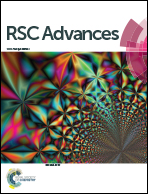Fast synthesis of mesoporous γ-alumina assisted by a room temperature ionic liquid and its use as a support for the promotional catalytic performance of dibenzothiophene hydrodesulfurization
Abstract
In the present work, mesoporous γ-aluminas have been successfully synthesized by calcining self-synthesized alumina sols in the presence of a room temperature ionic liquid, 1-butyl-3-methylimidazolium tetrafluoroborate. N2-adsorption measurements revealed that the ionic liquid had a significant influence on the textural structure of the final product. Aluminas prepared in this way displayed very rich porosities with narrow mesopores. As the ionic liquid content (IL/Al mol ratio) increased successively from 0 to 0.15, the products showed much larger pore volumes (0.32–1.44 cm3 g−1) and higher specific surface areas (253–352 m2 g−1). X-ray diffraction patterns and 27Al MAS NMR spectra revealed that the self-synthesized alumina sol firstly transformed into a boehmite phase and then became well-crystallized γ-alumina particles by calcining at 600 °C. As such, γ-alumina with improved textural properties and crystalline framework, could not only increase the dispersion of the active catalytic species, but could also enhance the diffusion efficiency and mass transfer of reactant molecules when employed as catalyst supports. The γ-alumina in this work demonstrated a remarkable enhancement in the catalytic performance of CoMo catalysts in dibenzothiophene hydrodesulfurization.


 Please wait while we load your content...
Please wait while we load your content...